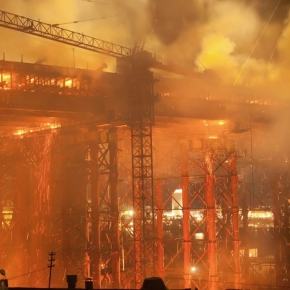
Bull’s tips to prevent a fire spreading on your construction site
Bull Products has shared its guide on how to prevent a fire from spreading on a construction site.
Implement the right products
Implementing the correct fire safety products is vital to prevent a fire from spreading and fire extinguishers are one of the most life-saving products to have on site.
Fire extinguishers should be located at identified fire points around the site and should be appropriate to the nature of the potential fire:
- Wood, paper and cloth – water extinguisher
- Flammable liquids – dry powder or foam extinguisher
- Electrical – carbon dioxide (C02) extinguisher
Consider how to detect fires
On a smaller site, a standalone alarm unit may be sufficient but as a construction site grows, there is a higher risk of a fire breaking out.
The installation of fire detection and wireless alarm systems, you can ensure workers are alerted in the event of a fire.
Bull’s Cygnus mobile detection device is an ideal solution for instant fire detection warning and can be used in conjunction with the Fire First Responder Station which connects the detector (smoke or heat) to the alarm on the station.
It is suitable for temporary hot works, as it can be moved to where the hazard is and then left there for a period of time to guarantee a fire does not start.
Carry out thorough staff training
It is crucially important to ensure staff are confident when using any type of fire safety equipment – they need to know what risks to be aware of and what actions to take in the event of a fire. All new employees should also receive fire safety training.
Review and update your risk assessment
According to The Regulatory Reform (Fire Safety) Order 2005 (FSO), a ‘responsible person’ must carry out, and keep up to date, a risk assessment and implement appropriate measures to lower the risk to life and property from fire.
The HSE recommends following these five steps when carrying out a fire risk assessment:
- Identify hazards: consider how a fire could start and what could burn
- Identify those at risk: employees, contractors, visitors and anyone who is vulnerable
- Evaluation and action: consider the hazards and people identified in 1 and 2 and act to remove and reduce risk to protect people and premises
- Record, plan and train: keep a record of the risks and action taken. Make a clear plan for fire safety and ensure that people understand what they need to do in the event of a fire
- Review: your assessment regularly and check it takes account of any changes on site.
By following these four tips, you can prevent a fire from spreading, which will protect your workers and site in the long-term.
Latest news

26th July 2024
Enfield Speciality Doors completes world-class project for Atlas Copco HQ
A rundown office and warehouse building completely transformed into a modern headquarters for Atlas Copco has been fitted with more than 120 internal fire doors from Enfield Speciality Doors.
Posted in Access Control & Door Entry Systems, Articles, Building Industry News, Building Products & Structures, Building Systems, Case Studies, Doors, Interior Design & Construction, Interiors, Posts, Restoration & Refurbishment, Retrofit & Renovation, Security and Fire Protection, Sustainability & Energy Efficiency, Timber Buildings and Timber Products, Wooden products
26th July 2024
Abloy UK launches new white paper
Abloy UK, a leading provider of security and access control solutions, has launched a new white paper.
Posted in Access Control & Door Entry Systems, Architectural Ironmongery, Articles, Building Industry News, Building Products & Structures, Building Services, Doors, Facility Management & Building Services, Health & Safety, Information Technology, Innovations & New Products, Publications, Research & Materials Testing, Security and Fire Protection
26th July 2024
MCRMA Member Profile: David Roy, Director of Roofconsult
David Roy of MCRMA member company Roofconsult has more than 50 years’ experience to draw upon working in the building envelope sector and a unique perspective on how it has changed in that time.
Posted in Articles, BIM, Infrastructure & CAD Software, Building Associations & Institutes, Building Industry News, Building Products & Structures, Building Services, Building Systems, Cladding, Information Technology, Restoration & Refurbishment, Retrofit & Renovation, Roofs, Walls
26th July 2024
Strand: Enhancing Door Functionality and Safety
Craig Fox, Sales Director for Strand Hardware, outlines how door industry professionals might apply door limiting stays…
Posted in Architectural Ironmongery, Articles, Building Industry News, Building Products & Structures, Building Services, Doors, Facility Management & Building Services, Health & Safety, Restoration & Refurbishment, Retrofit & Renovation
 Sign up:
Sign up: 